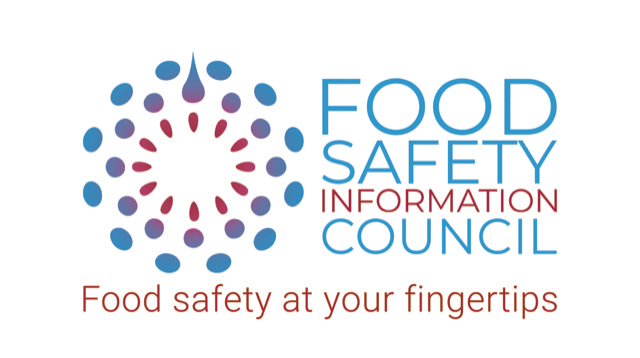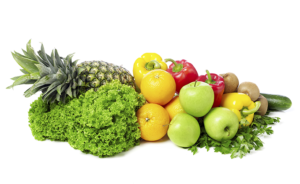Fruits and vegetables together with legumes and grains make up around 70% of a healthy diet. Plant foods provide a wide variety of nutrients and it is recommended Australian older children, teens and adults aim to eat at least two serves of fruit and five serves of vegetables or legumes each day.
Australians are lucky to have available an abundant supply of diverse and high quality fruits and vegetables. Fruits and vegetables, like other foods, should be handled with care to ensure they are nutritious and also safe. Many are eaten raw and therefore need to be protected from contamination with bacteria, viruses and harmful microorganisms. If they are cooked most harmful bacteria and viruses present will be killed.
How can fruits and vegetables be contaminated?
There are many types of fruits and vegetables and they are grown in many different ways: in open fields or enclosed structures; in soil or in water; on vines and trees, or in the case of sprouts they are germinated from seeds. They can be grown on a commercial scale on farms, and in home or community gardens.
Fresh fruits and vegetables can at times be contaminated with food poisoning microorganisms (e.g. bacteria and viruses) as they grow and are harvested on farm, during packaging, transport and food preparation. Fruits and vegetables can also become contaminated in the kitchen through contact with other contaminated raw foods, utensils and surfaces during preparation and storage. They can be contaminated by people handling them when they are sick and don’t practice safe hand washing and hygiene, or by washing them in unsafe water.
Purchasing fruits and vegetables
When you shop, avoid purchasing damaged (e.g. where the skin is broken) or mouldy fruit and vegetables. Check pre-cut products and salads to be sure you will consume them before the use by date expires, and that they are displayed chilled (e.g. in refrigerated cabinet). Protect fresh fruits and vegetables from contamination when shopping and transporting home by placing in plastic bags and keeping separated from raw meat, poultry and seafood. Refrigerate all pre-cut and packaged products, check for manufacturers’ storage instructions, and keep fresh fruits and vegetables in the special drawers separate from raw meats, poultry and seafoods.
Community and home gardens
Growing your own fruits and vegetables can be fun and provide a supply for fresh and nutritious produce. In our information on food safety basics and the environment we provide some tips for urban growers. Care is required in selecting the location, in using safe fertilisers and water, and protecting plants from pests. People tending and harvesting fresh produce should practice good hygiene.
Can food poisoning bacteria and viruses be removed from fruits and vegetables?
Whole fruits and vegetables will be contaminated mainly on the surface. Scrubbing and washing them in water or with sanitisers will remove loose soil and may remove many bacteria and viruses, as can removal of the skin.
However, fruits and vegetables are highly variable – they are not all easily cleaned and some are eaten with the skin on. For example, some have rough skins (e.g. rockmelons) making it difficult to clean, while others are very fragile (e.g. raspberries). Bacteria and viruses can be protected in cuts and crevices, so even after washing, at times there can still be contamination present.
When fruits and vegetables are cut, or if they are damaged, bacteria and viruses can be transferred from the surface onto the flesh. Cut fruits and vegetables should therefore be stored chilled and consumed within a few days [or within use-by date].
When you purchase packaged or wrapped pre-cut fruits and vegetables, you should check for instructions for storage and preparation. For example, pre-cut salad greens may have already been washed and sanitised during processing and are ready for use and re-washing these may only risk further contamination from the kitchen. Whole lettuce on the other hand may have instructions they should be washed before use.
Storage
You don’t have to store most whole fruit and vegetables in the fridge for safety. For example, store potatoes in a cool dark place where they won’t start to sprout as this generates toxins. Storing fruit in a bowl may result in them getting bruised from the weight of other fruit on top which could make them mouldy so you may prefer to store on a flat plate. Brush off any visible soil from vegetables and wash under running water and dry any fruit or vegetables just before you use them. If you wash them and then store them they may begin to grow moulds. If you’ve handled visibly dirty vegetables, like potatoes with soil on them, make sure you wash your hands, knife, peeler, and chopping board before you handle and prepare other foods.
Once whole vegetables and fruit are cut up or if their skin is damaged they should be covered and stored in the fridge where they can’t be contaminated by other food especially raw meat, chicken or seafood. Refrigeration slows the growth of food poisoning bacteria such as Salmonella and pathogenic E. coli on cut surfaces and the cut fruit can be stored for 2-3 days. However, it won’t stop the growth of Listeria and pregnant women, elderly and immuno-compromised persons should not eat these if stored longer than a day in the refrigerator.
Freezing
If you have excess fruits and vegetables you can freeze them by cutting up and blanching them by dipping them into boiling water – not only does this lock in the colour, flavour and texture, but it can also kill most food poisoning bacteria. It is best to freeze them by spreading in a single layer on trays, freezing, and then pack them in smaller portions for further storage. Frozen fruits and vegetables can safely be stored for a number of months, although there can be a loss in nutrient value and quality over time.
Home bottling or canning
Be vigilant if you bottle excess fruit and vegetables because of the risk of botulism. Commercial canneries follow strict time and temperature heating schedules that are capable of killing the botulinal spores. In home bottling, such regimes are not possible. If you are bottling at home, stick to the high acid fruits such as pears, apples and stone fruit – acid (low pH) prevents the growth of the bacteria that causes botulism. If you bottle tomatoes, mango, paw paw, banana or any other tropical fruit you must add some citric acid. Vegetables can only be safely bottled if bottled in vinegar.
If you want to produce your own vegetables in oil or flavoured oils you can keep them refrigerated for up to 10 days. If you want to bottle them, you need to acidify the vegetables and any fresh herbs first.

